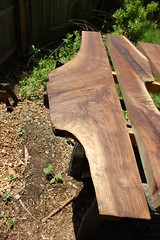What is American Black Walnut Hardwood Flooring?
Botanical Name: Juglans Nigra
Fast Facts
Color: The heartwood of American black walnut ranges from a purplish black to a dark brown. The sapwood is much lighter and is usually a tan or cream color. Because the difference in color between the sapwood and heartwood is so great, some manufacturers will steam the lumber in order to let the darker color from the heartwood bleed into the lighter sapwood, thereby reducing the substantial color variation.
Grain: The grain of the American black walnut is usually straight, however some boards may display a bit of curl.
Variations within Species and Grades: There are numerous variations in both color and grain in American black walnut. This is due to natural variations within the trees as well as the differences that occur based on the steaming and drying method used.
Hardness/Janka: The Janka scale rating for American black walnut is 1,010.
Dimensional Stability: The dimensional stability for American black walnut is average at 7.8.
Sawing/Machining: American black walnut has very good machining qualities.
Sanding: The lumber sands well.
Nailing: There are no known problems associated with nailing American black walnut.
Finishing: There are no known problems associated with finishing American black walnut.
Availability: American black walnut is moderately available.
Credit: NWFA
The American black walnut can be found from the eastern seaboard to the Great Plains and all the way down to the Gulf of Mexico. However, the largest commercial growth is located in the Central U.S., which claims nearly three quarters of all black walnut grown in the United States. The trees grow, on average, between 100 and 150 feet tall.
History
Historically, American black walnut was one of the species that was used primarily for furniture and cabinets although it was also favored for decorative panels and gunstocks. There are many traditions surrounding black walnut as well. Many Europeans consider black walnut as a symbol of fertility and walnuts were traditionally found at wedding ceremonies. One of the reasons the wood was so prized in items for the home, is that the wood darkens overtime and ages beautifully. In addition to being quite popular for the lumber produced, the tree also produces the very popular walnut. This nut is frequently used in all types of baked goods.
Durability
One of the most reliable indicators of durability in the industry is the Janka scale. The Janka scale ranges from zero to 4,000. A ranking of zero means the lumber is very soft and not at all suitable for flooring. A ranking of 4,000 indicates that the lumber is extremely hard and should not be used as flooring because of the difficulty associated with the milling process. American black walnut has a Janka scale rating of 1,010. Additionally the lumber has good shock resistance and is moderately dense. While American black walnut is a bit softer, and more prone to indentations, than red oak it is still exceptionally well suited to flooring.
Workability
American black walnut is easily worked with both hand and machine tools. It accepts nails, screws, and glue readily. Additionally, the lumber holds both stain and pain extremely well suited to finishing methods. Once the milling process is finished, American black walnut polishes beautifully. The only caveat is that the wood dries slowly, requiring the process to be slow and performed with care.
Where to use
The dark color makes American black walnut suitable for traditional décor. Because the wood can dent a bit more easily than other types of hardwood, it is important to consider the daily use the flooring will receive. For locations that will receive extremely high foot traffic, another type of flooring may be more desirable or special precautions may need to be made in those specific areas. As with all hardwood flooring, it is important that American black walnut flooring not be installed in areas that are exposed to excessive moisture or standing water as this can damage the flooring.
Care and Maintenance
As mentioned previously, American black walnut is a bit more susceptible to damage than some of the harder flooring options. Because of this, special preventative maintenance and care must be given to the flooring. If the flooring is going to be used throughout an area, evaluate the high traffic areas and provide a protective covering such as a rug or runner for those areas. Furniture may be more likely to cause indentions in the wood over time, and it is important to place pads under the legs of all pieces to prevent damage. Pets that will be walking on the floor need to have their nails trimmed regularly in order to limit their ability to cause tiny gouges in the flooring. In addition to these preventative measures, it is also important to develop a habit of regularly cleaning and caring for the flooring. Sweeping the floors on a regular basis or vacuuming them with a vacuum set to the hardwood flooring setting will remove the sand and other grit that is brought into the home on a regular basis. If the sand and grit are left on the floor, they will eventually scour the finish dulling the luster of the flooring and possibly damaging the wood as well. Spills should be cleaned up immediately to reduce the damage to the finish and to prevent any stains. Finally, additional instructions specifically suited to the type of finish chosen for the floor should also be consulted and followed.
Environmental Issues
American black walnut is one of the few trees American species that can naturally regenerate and thrive when planted. This explains its natural abundance and the ability of the species to thrive as an option for lumber. Where the trees are planted, however, they release a toxic material from the root system which can kill plants that are growing above them. If a location is not chosen carefully, this can harm the existing ecosystem.
